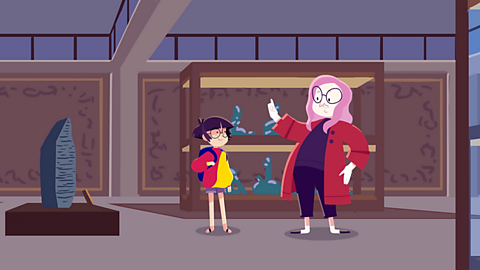How did Tutankhamun become Pharaoh?
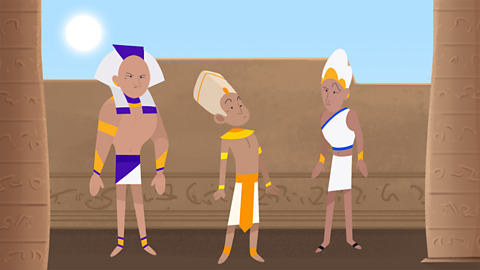
Pharaohs were the kings of Ancient Egypt. They ruled over the land, collected taxes from the people, enforced the law and led the Egyptian army against invaders.
Tutankhamun, or King Tut as he is also known, was the last of his dynasty of pharaohs.
He ruled as a boy only for a short time. He is most famous because his tomb was discovered almost intact and full of treasures in 1922.

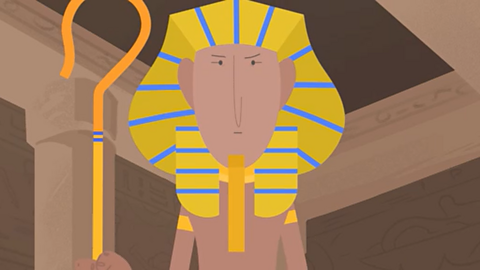
Tutankhamun became pharaoh after the death of his father Akhenaten. Some people liked how Akhenaten ruled but others didn't. He outlawed all of the gods except for one called Aten.
The people were very unhappy with this change and, after Akhenaten's death, destroyed many of his statues and monuments.
Watch: Who was Tutankhamun?
Learn about the famous Egyptian Pharaoh Tutankhamun.
Child: Tutankhamun, ruler of Egypt, from around 1332 to 1323BC.
Tutankhamun: Yes, thatâs me.
Child: Youâre Tutankhamun?
Tutankhamun: The very same.
Child: I was expecting someoneâŠ
Tutankhamun: Older? Iâve been king since I was nine you know.
Child: Wow! I wasnât even allowed to walk to school on my own and youâre in charge of a whole country?
Tutankhamun: I do have advisers. General Horemheb and an official called Ay, who help me make decisions.
Child: You havenât ruled for long though.
You must have made a big impression!
Tutankhamun: Ah, thatâs mainly because I fixed some mistakes my dad made.
You see, he forced everyone to worship a god called Aten which was pretty unpopularâŠ
So Iâve let people worship their old gods and built lots of statues to them.
Child: So whatâs all this stuff?
Tutankhamun: Just a few bits and pieces Iâll bring on my journey into the afterlife.
Child: Woah! Youâve got jewellery, chariots, furniture, wine, weapons⊠and board games?
Tutankhamun: Well, the afterlife goes on for a while so Iâll need something to do.
Child: I hope youâll keep this lot safely tucked away in a tomb.
Tutankhamun: Yeah, sure, itâll be in a tomb in the Valley of the Kings, so itâs like⊠well safe!
Child: I wouldnât be so sure. My local museum has lots of things archaeologists have brought back from expeditions to Egypt.
Iâm sure some of these items look familiar.
Explorer: Can you see anything?
Howard Carter: Yes! Wonderful things. Wonderful things!
What do we know about Tutankhamun?
Tutankhamun inherited the throne around age 9 and became Pharaoh in around 1332 BC. Because he was so young, he had powerful advisers around him to help him rule Egypt. They included General Horemheb and Grand Vizier Ay.
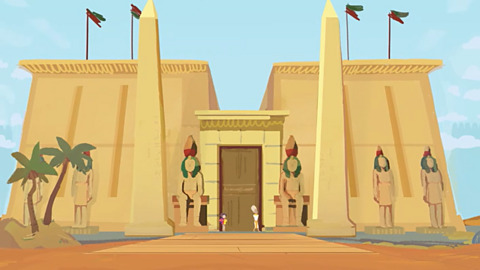
Tutankhamun reversed many of his fatherâs decisions. People were allowed to worship the old gods again and damaged temples were repaired. He moved the Egyptian capital back to Thebes.
Tutankhamun reigned for roughly 10 years. He died around the age of 18, possibly from malaria, and was buried in a tomb in the Valley of the Kings. Tutankhamun married his half-sister but their children did not survive. He was succeeded by his vizier, Ay.
Watch: Tutankhamun's tomb
Dan Cruikshank tells the story of Howard Carter's discovery of Tutankhamun's tomb.
This is it. This where it happened. The magical moment. Where Carter found the entrance to the tomb.
Itâs been tidied up a bit since his time but nevertheless itâs all very exciting.
Down these few steps is the entrance to the tomb itself.
This is the first door where Carter found the seals intact. He then removed the rubble and go down a descending passage as I am now.
Carter reached the second door here it is. Also filled with rubble, plastered over, seals intact. Goodness me, this is exciting.
Well, he then met a hole here, I suppose hoping against hope that they wouldnât see a sea of devastation. Look through this little huddle and saw something that made him turn back to Carnarvon up there and say âI can see wonderful thingsâ.
He realised the tomb had not been pillaged by robbers in antiquity much survived.
He saw in front of him a series of ritual couches, gilded with animal heads, chests down there, a great treasury of artefacts, bits of chariots all around.
And over here, where we came in, there is a wall since removed, a rubble wall, dividing this the antechamber from the burial chamber.
Here we see the sarcophagus of Tutankhamun with all the coffins inside it. Of course inside that coffin is the young pharaohâs body.
Why is Tutankhamunâs tomb so famous?
Tutankhamun's tomb was hidden for many centuries. It was covered in debris from other tombs and then hidden by workers' houses.
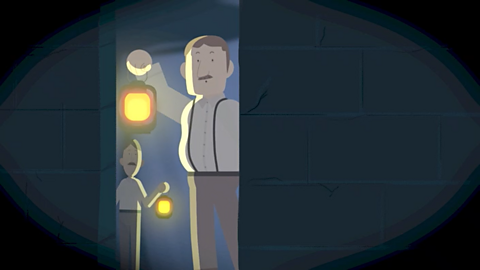
In 1907 it was declared that there was nothing left to find at the Valley of the Kings but in 1922 the Egyptologist Howard Carter discovered the tomb. On the 17th February, 1923, the seal to the tomb was broken and a living human stepped inside for the first time in 3,200 years.
What was inside Tutankhamun's tomb?
The tomb contained 5,398 items, including:
- Tutankhamunâs famous golden death mask
- a solid gold coffin
- thrones
- trumpets
- fresh linen
- a chariot
- a dagger made from meteorite iron.
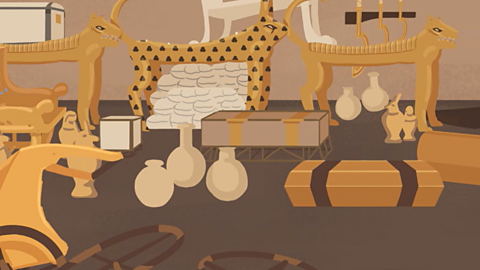
It took Howard Carter ten years to catalogue the finds from the tomb. Parts of Tutankhamunâs chest with a beaded collar were stolen after the discovery, along with his skull cap!
What did Tutankhamun look like?
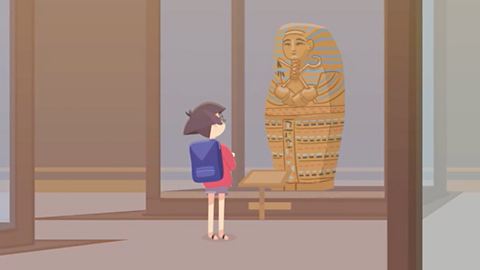
We know what Tutankhamun looked like because scientists have done experiments on his skull, bones and DNA.
Tutankhamun was slim, 5â6â tall with rounded hips, a narrow waist and large front teeth.

Famous Pharoahs
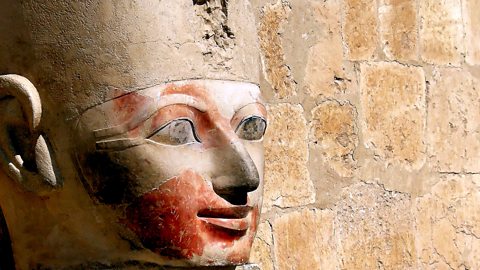
Image caption, Hatshepsut (1478 - 1458BC)
Hatshepsut was the longest reigning female pharaoh of Ancient Egypt. She is considered one of the most successful pharaohs. She commissioned hundreds of grand buildings and established important trade routes.
Image caption, Amenhotep III (1391 BC - 1353BC)
Amenhotep III built many of Ancient Egypt's famous monuments, including the Luxor Temple and the Colossus of Memnon.
Image caption, Ramesses II (1279 - 1213BC)
Ramesses II was one of the most powerful pharaohs. He led many military expeditions, founded cities and had huge statues of himself built.
Image caption, Cleopatra VII (51 - 30BC)
Cleopatra VII was Ancient Egypt's last pharaoh, after her reign Egypt became a part of the Roman Empire.
1 of 4
Activities
Activity 1: Solve the puzzle
Activity 2: Quiz â King Tutankhamun
Activity 3: Make your own Tutankhamun mask
Download the ancient Egyptian headdress, colour it in and after placing it on your head, declare yourself Pharoah!

Activity 4: History Explorer game
Play this game to test your knowledge and learn even more facts about Ancient Egypt.
History Explorer: Secrets through time
History Explorer: Secrets through time: KS2 History

Bitesize Primary games. gameBitesize Primary games
Play fun and educational primary games in science, maths, English, history, geography, art, computing and modern languages.

More on Ancient Egypt
Find out more by working through a topic
- count8 of 18
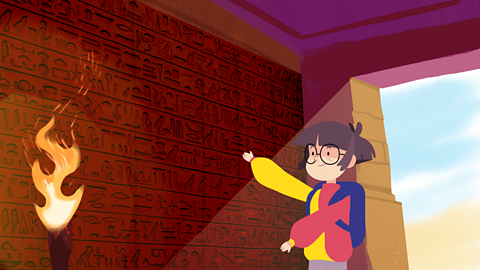
- count9 of 18
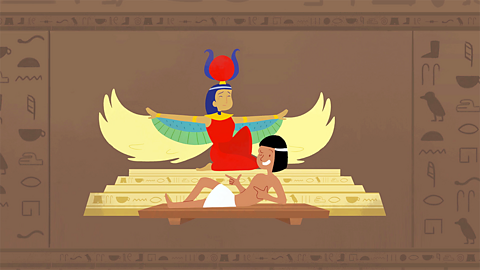
- count10 of 18
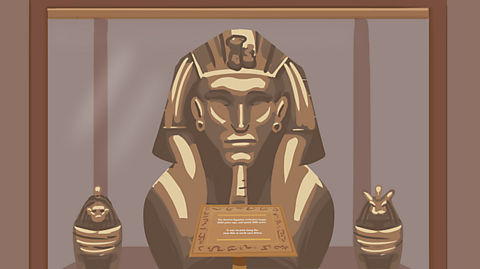
- count11 of 18
